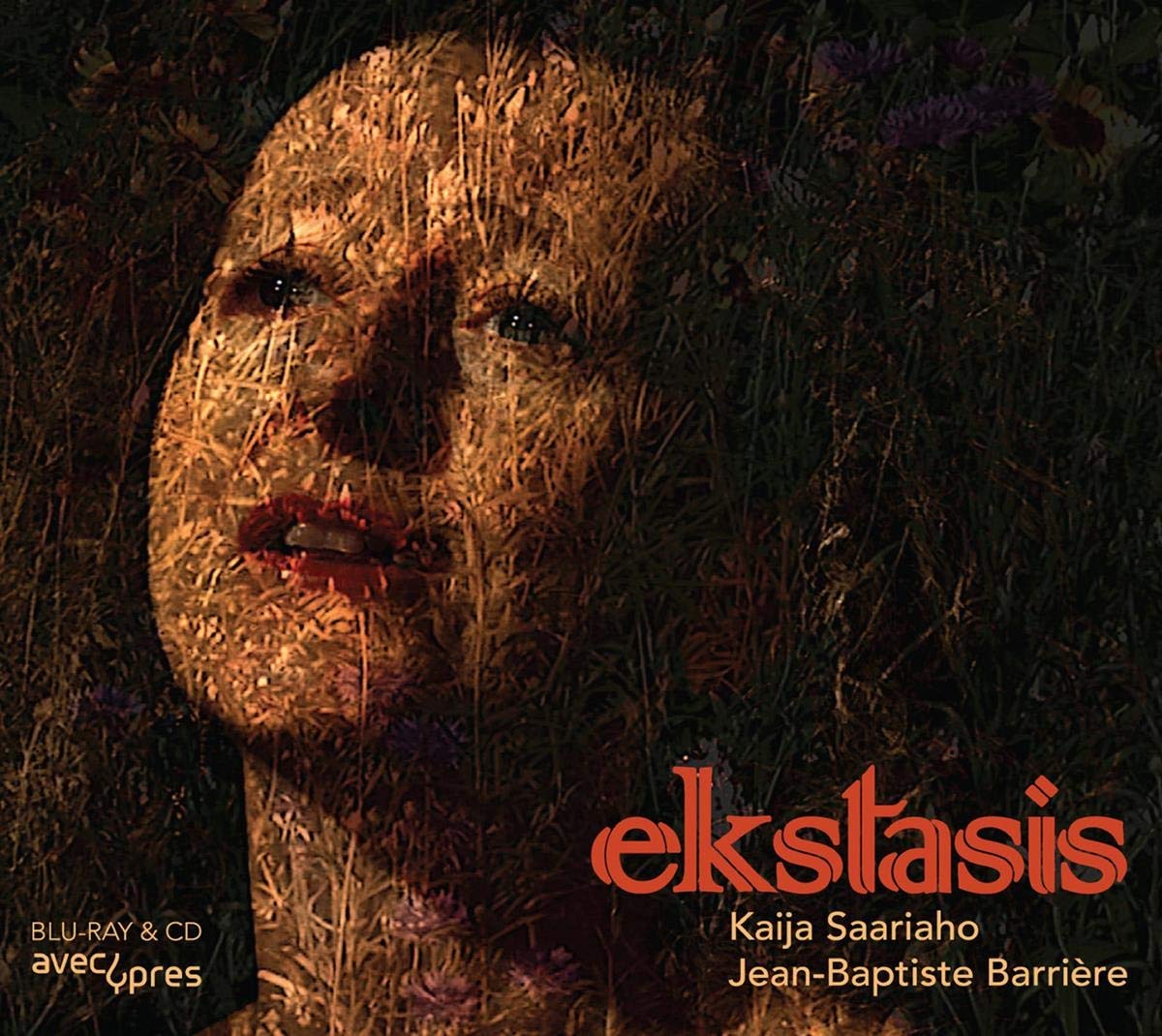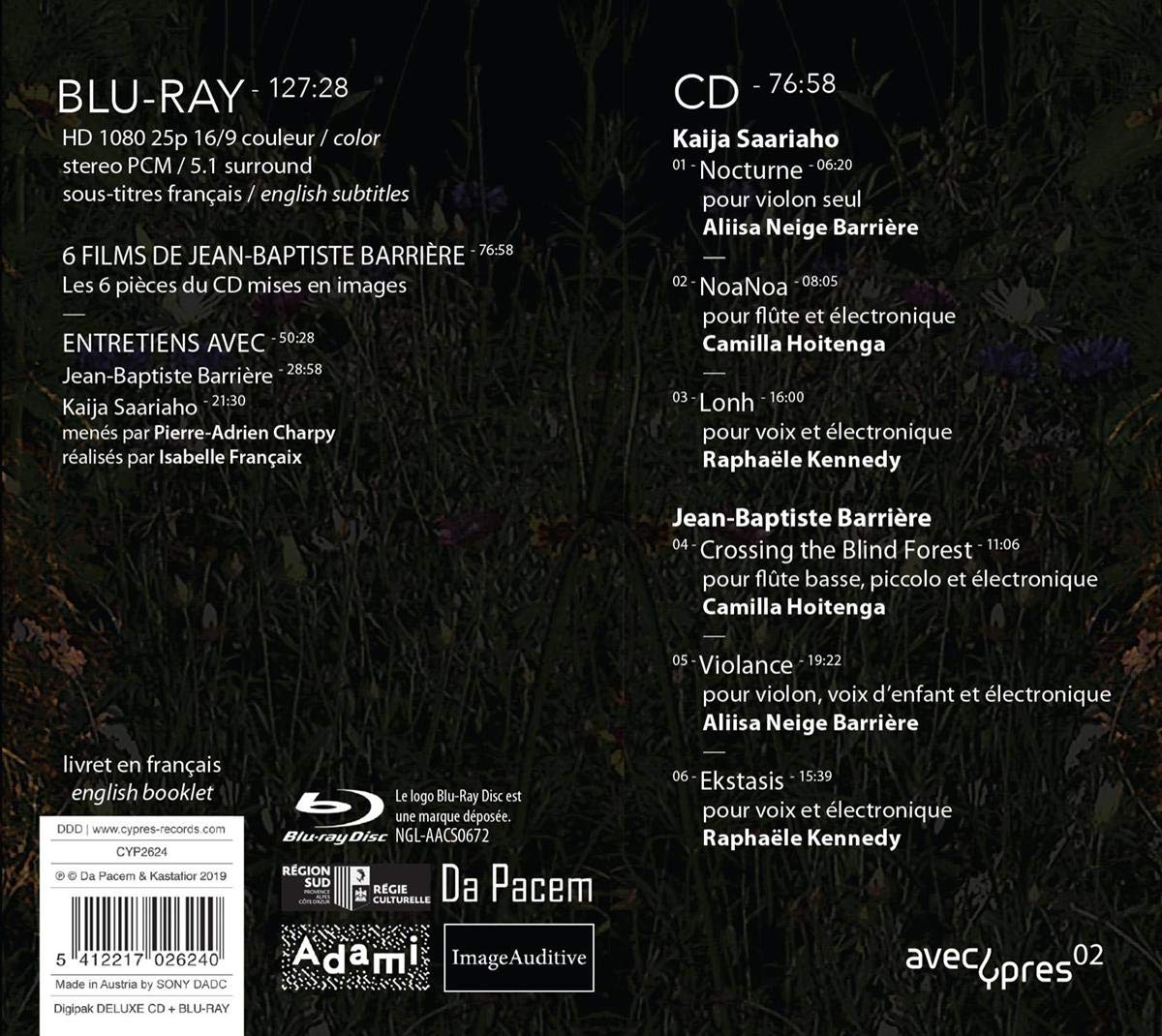

Ekstasis short musical “films.” Jean-Baptiste Barrière directs 6 short avant-garde audio/visual recordings:
Kaija Saariaho Nocturne with violinist Aliisa Neige Barrière (6:20)
Kaija Saariaho NoaNoa with flutist Camilla Hoitenga (8:05)
Kaija Saariaho Lonh with soprano Raphaële Kennedy (16:00)
Jean-Baptiste Barrière Crossing the Blind Forest with flutist Camilla Hoitenga (11:06)
Jean-Baptiste Barrière Violance with violinist Aliisa Neige Barrière (19:22)
Jean-Baptiste Barrière Ekstasis with soprano Raphaële Kennedy (15:39)
Package includes a Blu-ray video disc and a CD of the music. The video disc also has substantial interviews with both composers. Released 2019, disc has 5.1 PCM sound. Grade: A
Kaija Saariaho is a Finnish composer who is married to the French composer Jean-Baptiste Barrière. They live in Paris and are associated with the Institute for Research and Coordination in Acoustics/Music, or IRCAM. Aliisa Neige Barrière, the violinist, is their daughter. One Isabelle Barrière (maybe the sister of Jean-Baptiste) worked on video shooting, editing, and color grading. It seems this whole disc was created and produced by a tiny family business working with the equally tiny Avecypres recording label run by singer Raphaële Kennedy. I don’t think there are any computer generated images involved here like those in video games or science-fiction movies. All the images are natural, although many are shot in front of green screen. Computers are used (1) to treat and combine the natural images in many ways and (2) to create original electronic music.
Nocturne
This is a short, simple work for solo violin, no electronic music, and images. The video is manipulated to create duplicate or multiple images of the soloist and the instrument in real time. This results in a remarkable and somewhat mysterious aural and visual statement:
NoaNoa
NoaNoa is a piece for solo flute, electronic music, and images inspired (at least in part) by woodcuts (called the NoaNoa Suite) made by Paul Gauguin. These woodcuts all relate to Gauguin’s first visit to Tahiti:
Below is a kind of self-portrait of Gauguin with his chin resting on his fist:
Many other woodcuts show up in NoaNoa similar to the next screenshot below:
Lonh
Lonh is for voice, electronics, and images. “Lonh” means “far away” in Occitan. It’s the lovesong of a hapless troubadour to a woman he will meet only when he dies. Here it is sung in a straight-forward rendition by Raphaële Kennedy. The video is remarkable for a series of very different images in various styles, three of which are shown below:
Crossing the Blind Forest
If anything, these “electronic” modern works are eclectic. Because they are rarely realistic or naturalistic, they tend to relate well to political statements, Symbolist artists, and tellers of parables like Brueghel, whose The Blind Leading the Blind is seen in our next screenshot. This painting was the inspiration for Jean-Baptiste Barrière’s Crossing the Blind Forest:
Crossing the Blind Forest is for bass flute, piccolo, electronics, and images. The solist is Camilla Hoitenga:
Here Hoitenga has switched from bass flute to piccolo:
Violance
Violance, written for violin, child’s voice, electronics, and images is a deliberate misspelling of “violence.” It’s inspired by another Brueghel painting, the Massacre of the Innocents seen next below. On the right side of this painting about half way up, note the image of a man in a green coat riding a gray and white horse surrounded by 9 peasants begging that the children in the village not be killed:
Now next below is Aliisa Neige Barrière playing violin with an image of the Massacre painting in the background. You should be able to easily spot the horseman in the green coat on the upper right:
Much of Violance consists of a recitation by a young girl of a description of the massacre in a piece by Maurice Maeterlinck. Next below is a image of the girl bleached out by a computer program to give her a ghostly appearance:
Ekstasis
Ekstasis is a political commentary celebrating the lives and words of Lousie Michel, the “Red Virgin” of the 1871 Paris Commune and Simone Weil, the French political activist who warned Trotsky that intellectuals could be more dangerous than capitalists:
The screenshots above together with the video below should give you plenty of opportunity to decide if this interests you. The quality of performance and presentation is very high. The disc package and booklet is quite beautiful and generous with a Blu-ray disc and the CD. Disc authorship is good enough: to get the excellent English subtitles, make your selection at the top menu screen (you can’t toggle subtitles as you go along). We haven’t anything else like it on our website. After a debate, we tagged his as “performance art” and “motion picture." This gets an A grade for artistic quality and good fit and finish. Whether viewers will be interested in this kind of presentation of fine-art sight and sound remains to be seen.
OR




















